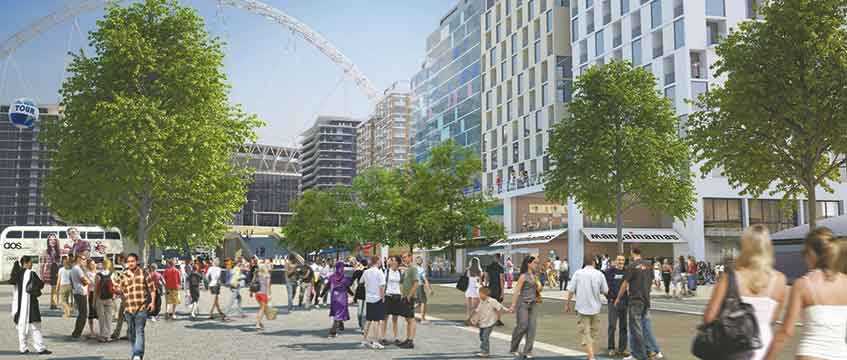Quintain’s investment memorandum for the £2.5bn sale of the UK’s largest PRS development includes detailed proposals for expanding the business to a 30,000-flat operator by 2028.
A sale of Quintain and its 5,000 PRS homes at Wembley by Lone Star was revealed in March. The £6.5bn scheme, which could have up to £200m of income when stabilised, would be one of the largest-ever single-site sales in the UK and would dwarf any other residential deal.
It would also give instant scale to an investor in a sector where many are clamouring for units.
At the moment just 250 of the 5,000 rental units are operational, but the speed of the turnaround has been rapid. Lone Star bought Quintain a little over two-and-a-half years ago for around £745m.
Since then it has gained full masterplanning for the site, arranged for the vast majority of it to be PRS, agreed an £800m refinancing and organised one of the UK’s fastest build-outs over the next six years. –
How Wembley breaks down
■ 7,000 flats (1,700 completed)
■ 726,000 sq ft of retail
■ 633,000 sq ft of offices
Rental flats
■ 5,000 PRS flats
■ 250 currently operational
■ 3,065 under construction
■ 295 to be finished by the end of 2018
■ More than 1,000 to be online by the end of 2019
■ More than 2,300 PRS flats to be online by the end of 2020
■ All PRS flats completed by 2024
Quintain chief executive Angus Dodd, who will stay with the company, says that further scale is essential to get value in the UK PRS, which is a low-margin business.
“What is becoming clear to us is there is a real opportunity for a small handful of dominant players to emerge from this market, as at the moment it is pretty fragmented,” Dodd says. “Everyone is racing for scale as the business only works at that level: and scale is not even 5,000-10,000 flats, but 20,000 to 30,000 units under management.
“The reason that scale is so important is that it a low-margin business with an obsession with gross- to net leakage and, more relevantly, net operating income.”
Dodd says there are three ways to achieve that expansion: buying more sites, taking on third-party management contracts and through M&A.
Rents at Wembley
In the Alto block:
■ Studio: £1,725 pcm
■ One-bed: £1,755 pcm
■ Two-bed: £1,985 pcm
■ Three-bed: £3,495 pcm
2.5 years of ownership
■ October 2015: Lone Star buys Quintain for around £1bn
■ March 2016: Quintain’s PRS management and operating company, TIPI, launched
■ May 2016: Revised masterplan approved
■ October 2016: £800m development finance agreed with three North American lenders
■ February 2017: Quintain reveals 5,000 flats to be PRS and finished by 2024
■ March 2018: Sale of Quintain announced, with Credit Suisse and Eastdil appointed
Key considerations at Wembley
Letting rates
Information on letting rates is scarce and often closely guarded, but in general lettings on larger blocks average around 20 flats a month.
Applying this to the 5,000 units at Wembley means it could take more than 20 years to let all the units, and that does not take into account reletting. Doubling that rate to 40 a month, it would take 10-and-a-half years.
Rents could be dropped to encourage faster lettings, but this would affect its valuation, as rental schemes are valued on stabilised yield. The hope could be that the multitude of different blocks will act in the development’s favour and allow them to be let concurrently.
Build out and contractors
So far 1,700 flats have been completed, but only 250 rental flats.
By the end of 2018 a further 295 will be online. More than 3,000 are under construction, with four contractors appointed – Wates, McLaren, John Sisk & Son and McAleer & Rushe – on fixed-price contracts.
All of this aims to make it as straightforward as possible for potential buyers. The office and residential developments not yet being built do not have contractors appointed.
The commercial element
The vast majority of value at Wembley is driven by the residential development, but there is a substantial component of shops and offices: 726,000 sq ft and 633,000 sq ft respectively.
Quintain does not intend to break up ownership of the estate by selling these elements, which could allow alternate and competing visions for the site. This means any prospective buyer would have to be comfortable with taking on the commercial component as well.
The developer has been working hard to improve the retail element to make Wembley more of a destination: the 264,000 sq ft London Designer Outlet is valued at close to £130m and has more than 70 tenants, while a 27-unit Boxpark has been agreed. Another 250,000 sq ft of retail sits at the base of the residential buildings.
A 110,000 sq ft office building, already 60% prelet, is under construction, and there is consent for a further 400,000 sq ft of offices.
Concentration
Quintain and Lone Star have never been concerned with the concentration of the estate and believe it acts in its favour – hence the sell-off of Quintain’s more peripheral assets.
However, some PRS operators do not like a concentration of flats in one area. Grainger chief executive Helen Gordon said it would not be looking at the Wembley project because it is too geographically concentrated. Grainger’s investment strategy is focused on a national spread.
Getting scale and a good time to sell
The Wembley sale offers immediate scale, which is something many investors have been clamouring for. It could be it greatest attribute. Several companies have tried to enter the UK PRS, saying they will invest billions and build a pipeline of 5,000 homes. The Quintain offer provides just that.
To send feedback, e-mail alex.peace@egi.co.uk or tweet @egalexpeace or @estatesgazette











